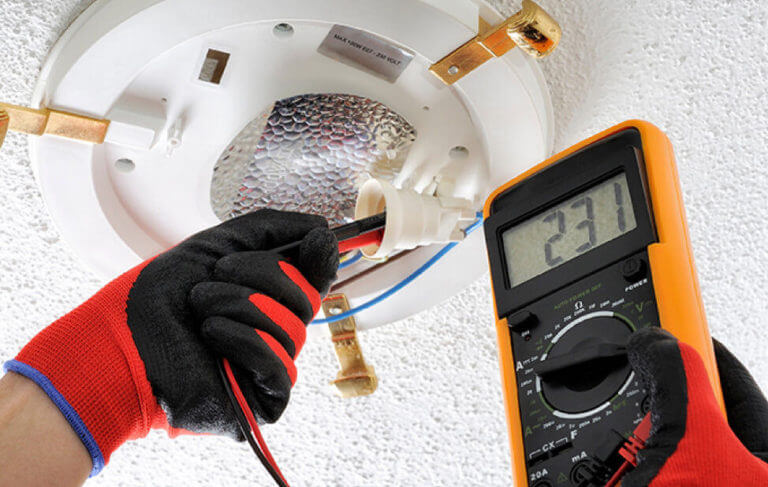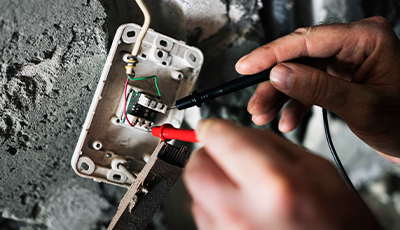Common Electrical Problems Every Property Owner Ought To Understand about
Home owners often experience numerous electric troubles that can influence safety and security and functionality. Issues like flickering lights and stumbled circuit breakers are a lot more typical than many recognize. These circumstances can show much deeper electrical issues that warrant focus. Comprehending the indicators and threats connected with obsolete electrical wiring and dead electrical outlets is necessary. What measures can be required to prevent these troubles? Discovering these common electrical concerns could expose crucial understandings for preserving a safe home setting.

Flickering Lights: Causes and Solutions
Why do some house owners experience flickering lights? Flickering lights can be an usual aggravation, typically indicating underlying electric concerns. One main cause is loosened or malfunctioning connections within light components or electrical wiring, which can result in periodic power supply. Furthermore, utilizing high-wattage appliances on the very same circuit may cause voltage fluctuations, causing dimming or flickering. An additional possible issue is an overloaded circuit, where way too many gadgets draw power concurrently, straining the electric system. Degraded or obsolete wiring can contribute to inconsistent electric circulation. In some cases, flickering lights may signal a trouble with the home's electrical panel or service line. Homeowners ought to address flickering lights immediately to stay clear of possible dangers. Solutions may consist of tightening up connections, rearranging device lots, or consulting a licensed electrical contractor for a thorough assessment. Determining the source can help guarantee a secure and risk-free electric system in the home.
Tripped Circuit Breakers: What You Need to Know
Have property owners ever questioned what creates their circuit breakers to trip suddenly? This usual problem often emerges from an overload of electric circuits, where way too many devices draw power concurrently. In such cases, the circuit breaker functions as a safety and security device, disrupting the flow of power to stop getting too hot and prospective dangers. Another frequent reason is a brief circuit, which happens when an online cord get in touches with a neutral cable, developing a surge of power that journeys the breaker. Ground mistakes can likewise lead to tripped breakers; these occur when an online wire touches the ground or a based surface, positioning serious safety and security risks. Homeowners ought to routinely assess their use of high-wattage devices to stay clear of overloading circuits. In addition, comprehending the function of breaker can assist them respond suitably during a trip, ensuring their home stays risk-free and properly maintained.
Obsolete Electrical Wiring: Dangers and indicators
Out-of-date circuitry can present considerable risks to house owners, often going unnoticed till problems arise. Residences developed prior to the 1980s might still have light weight aluminum circuitry or knob-and-tube systems, which are no more thought about secure. Indications of obsolete electrical wiring consist of flickering lights, regularly stumbled circuit breakers, or burning scents near electrical outlets. These indicators may suggest that the electrical system is loaded down or deteriorating.Additionally, property owners may notice scorch marks around electrical outlets or buttons, which can indicate getting too hot. The risk of electric fires markedly boosts with out-of-date electrical wiring, as these systems were not made to handle modern-day electrical loads. Home owners are urged to have their circuitry evaluated on a regular basis, especially when refurbishing or adding new devices. By identifying these indicators early, they can stay clear of harmful circumstances and keep a much safer living setting. Upgrading to present electrical standards is a positive action in keeping home safety and effectiveness.
Frequently Blown Fuses: Troubleshooting Tips
Frequent blown fuses can indicate underlying electrical issues that might stem from obsolete wiring or overloaded circuits. Property owners experiencing this problem must initially determine the home appliances attached to the affected circuit. It is a good idea to prevent using numerous high-wattage tools all at once, as this can bring about circuit overload. If the problem continues, examining the fuse box for indicators of wear or damages is vital; a faulty fuse box may need replacement.Additionally, looking for loose connections within the circuit can help stop future occurrences. House owners must also verify that the fuses being used are of the proper amperage, as making use of an incorrect fuse can exacerbate the issue. Speaking with a licensed electrical expert is suggested to assess the electric system better if these repairing suggestions do not resolve the issue. Addressing these issues without delay can help alleviate risks and assure the safety and security of the home's electric framework.
Dead Electrical Outlets: Usual Causes and Fixes
When a property owner comes across a dead outlet, it can often provide aggravation and complication. Several common article causes may lead to this problem. One frequent perpetrator is a stumbled circuit breaker, which can be easily reset. Homeowners need to check their electrical panel to examine if any breakers are in the off position. Another possibility is a defective electrical outlet itself, which might require replacement. Furthermore, loose wiring connections within the outlet can interfere with power circulation, making inspection essential.Sometimes, the issue might stem from an overloaded circuit, especially when multiple tools are connected. In such situations, redistributing the electric load can resolve the concern. Property owners ought to additionally take into consideration the age of their electrical wiring; older systems may require updates to satisfy contemporary electrical needs. If these steps do not rectify the situation, getting in touch with a certified electrical contractor is suggested to ensure security and appropriate medical diagnosis.
Electrical Shocks: When to Be Worried
Just how can home owners establish whether an electric shock warrants issue? House owners must first assess the severity and context of the shock. A moderate fixed shock, commonly felt when touching steel things, is commonly harmless and typical. If the shock takes place while interacting with a plugged-in device or electrical outlet, it might show a much more significant issue.The location and frequency of the shocks are vital. Repetitive shocks from the very same resource, especially in damp locations like cooking areas or washrooms, could signify faulty circuitry or inadequate grounding. Home owners need to likewise take into consideration the sensation of the shock; a jolt that creates pain or muscular tissue tightenings is much more alarming than a mere tingle.If there's any uncertainty, it is recommended to get in touch with a certified electrical expert. Ignoring possible electrical hazards can bring about significant security risks, consisting of fire or extreme injury.
Overloaded Circuits: Avoidance and Safety Procedures
Overloaded circuits position significant dangers in household read settings, frequently causing electric fires or equipment damages (Sydney Level 2 Electrician). Homeowners should acknowledge the signs of an overloaded circuit, such as regularly tripped breakers or dimming lights. Implementing precautionary safety practices can assist mitigate these threats and ensure a safer living atmosphere
Acknowledging Overloaded Circuits
What signs suggest that a circuit may be overwhelmed? Home owners should be attentive for numerous essential signs. Frequently tripped circuit breakers or blown fuses suggest too much tons on the circuit. Dimming or flickering lights, especially when various other appliances remain in usage, can symbolize a poor power supply. Additionally, electrical outlets or switches that feel cozy to the touch may suggest overheating, a potential fire risk. Uncommon humming sounds from outlets also necessitate attention, as they can signify electric concerns. Finally, if home appliances run inefficiently or fail to begin, it may suggest an overloaded circuit. Recognizing these indications early can help avoid severe electric issues and promote a much about his safer home environment.
Preventive Safety Practices
To maintain a safe and reliable electrical system, home owners have to execute preventative safety methods that attend to prospective circuit overloads. One effective procedure is to stay clear of attaching way too many devices to a single electrical outlet, as this can exceed the circuit's capability. Making use of power strips with integrated circuit breakers can help disperse power securely. House owners should also routinely examine cords and appliances for damages and replace any faulty devices without delay. It is crucial to ensure that circuit breakers are functioning correctly and to be knowledgeable about the overall wattage being used in each circuit. Additionally, speaking with a qualified electrical expert for routine examinations can recognize possible concerns before they intensify, assuring a more secure living atmosphere and prolonging the life-span of electric systems.
Often Asked Concerns
Exactly how Often Should I Have My Electrical System Inspected?
Regular assessments of electrical systems are advised every three to five years. Homeowners need to think about extra regular checks if they experience problems, take on remodellings, or live in older properties to guarantee safety and security and compliance.
Can I Take Care Of Electric Problems Myself or Work With a Professional?

What Are the Signs of an Electric Fire Danger?
Signs of an electric fire danger include often stumbled circuit breakers, flickering lights, melting smells, stained outlets, or cozy, humming cords. Property owners must continue to be vigilant and look for specialist support if any of these indications are present.
Exactly how Do I Know if My Home Needs an Electrical Upgrade?
To determine if a home requires an electric upgrade, indicators consist of regular breaker trips, outdated circuitry, inadequate outlets, flickering lights, and the visibility of older electric panels, showing possible safety hazards and inadequacy.
Are There Certain Security Tips for DIY Electric Job?
When taking into consideration do it yourself electrical job, one ought to constantly transform off power, make use of insulated tools, validate circuit capability, follow neighborhood codes, and get in touch with experts for complicated jobs to guarantee safety and security and protect against accidents. One more prospective problem is an overloaded circuit, where also several devices attract power at the same time, straining the electrical system. The threat of electric fires markedly raises with outdated electrical wiring, as these systems were not made to take care of modern electric lots. Frequent blown merges can indicate underlying electric issues that may stem from out-of-date wiring or overloaded circuits. To keep a effective and risk-free electrical system, homeowners should implement preventive safety techniques that resolve prospective circuit overloads. Accredited Service Provider Level 2 Electrician. Indicators of an electrical fire threat include often tripped circuit breakers, flickering lights, burning smells, stained outlets, or warm, buzzing wires